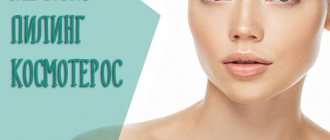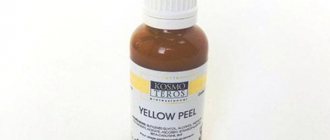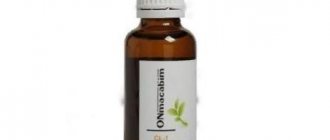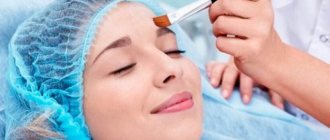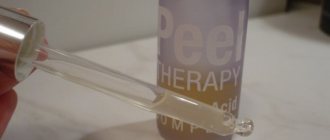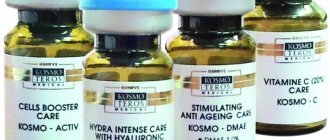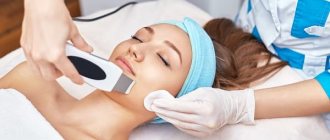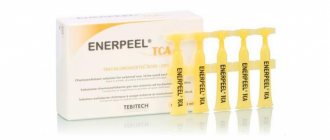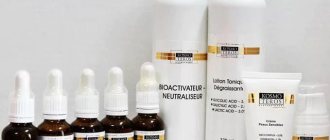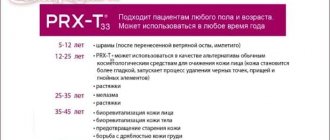Why "yellow"?
The official name of this facial peeling is retinoic , but people call it “yellow” because a yellow mask remains on the face during the procedure.
It is also called a “weekend peel” due to the rapid healing of the skin. It takes two days. Therefore, many women sign up for the procedure on Friday, and on Monday appear at work refreshed or as if they had flown to the sea on the weekend.
Types of chemical skin peeling
Superficial peeling is the most gentle and safe way to refresh and rejuvenate the face, neck and décolleté. The impact is only on the thin stratum corneum of the epidermis (the outermost layer of the skin), so side effects from this procedure are practically eliminated (subject to all rules of post-peel care). When talking about superficial peeling, the expression “weekend peeling” is often used, since rehabilitation takes approximately the same period of time as a weekend.
The method helps improve the color and structure of the skin, is effective in combating acne and seborrhea, but does not guarantee getting rid of deep wrinkles, unevenness, and large age spots. Typically, patients under 40 years of age resort to this procedure to correct minor problems.
Depending on the condition and needs of the skin, lactic and fruit acids (AHA), salicylic acid, glycolic acid or 10-15% trichloroacetic acid are used for superficial peels. Instead of acids, enzymes can be used (enzyme peeling or enzymatic peeling). All these compositions, in addition to exfoliating dead cells, are designed to solve different problems (regulating hydrobalance, reducing pores, increasing tone, reducing inflammation, lightening, etc.), therefore, a cosmetologist can determine which active ingredient is preferable for the patient only after a face-to-face meeting .
Very popular in recent years, retinoic peeling or yellow peeling (active ingredients - retinol, retinoic acid) also belongs to superficial peelings in terms of the type of action on the skin, but is closer in effectiveness to medium peelings.
Retinoic peeling (retinol cleansing) is the choice, for example, when working with mature and/or pigmented skin, as well as skin prone to rashes.
Superficial peelings are usually carried out in courses of 4-6 procedures with a frequency of no more than once a week.
Medium peeling - its effect extends to the entire structure of the epidermis to the basement membrane. This is a very effective procedure, but the patient should be prepared for unpleasant sensations - with medium peeling, the concentration of acids is higher than with superficial manipulations, so the degree of skin damage is greater. The procedure involves further rehabilitation at home for about 7-10 days (due to severe redness and flaking of the skin).
Medium peels usually include trichloroacetic acid (or TCA) at a concentration of 30-40%, salicylic acid, and Jessner's solutions. By exfoliating dead skin cells of the epidermis, these components penetrate into the deep layers of the skin, causing the activity of living dermal cells. The procedure helps restore the protective properties of the skin, improve its turgor, increase density and elasticity. After medium peeling, manifestations of sagging skin go away, wrinkles straighten, scar elements, stretch marks, and age spots are smoothed out.
The procedure is carried out exclusively in the autumn-winter period, since renewed skin becomes especially susceptible to sunlight, and this threatens hyperpigmentation. The recommended course is from five sessions.
Deep peeling is the most impressive in action, but also the most traumatic. This is a serious chemical burn that damages the skin to the point of “blood dew.” This procedure is carried out under anesthesia and only in a hospital setting. The rehabilitation period after deep peeling can take months, but the effect will last for several years.
This procedure is also called phenol peeling because it is performed using phenol (carbolic acid). Under the influence of this substance, the entire stratum corneum of the skin is burned, and with it wrinkles, scars, signs of sagging and sagging skin. The density and elasticity of the epidermis is renewed and restored, and the structure of the dermis is rejuvenated.
Indications for such peeling may include age from 60 years or the presence of significant skin defects.
There is no need to talk about deep peeling as a course procedure because of its high traumatic and painful nature. A repeat is possible no earlier than in a few years.
Since chemical peeling is a radical method, the procedure must be carried out by a highly qualified dermatocosmetologist in a specially equipped medical office!
Indications for chemical peeling:
- biological aging;
- small superficial wrinkles;
- enlarged pores;
- freckles;
- dark spots;
- acne, post-acne;
- melasma;
- lentigo;
- stretch marks (stretch marks);
- sagging skin.
Contraindications to chemical peeling
- cancer;
- poor wound healing;
- tendency to form scars;
- pronounced rosacea;
- infectious diseases;
- dermatological diseases;
- chronic diseases in the acute stage;
- pregnancy and lactation;
- tan, very dark skin;
- recent invasive cosmetic procedures;
- taking certain medications.
1 Superficial chemical peeling procedure
2 Applying regenerating cream
3 Applying regenerating cream
Pros of yellow peeling
Fast recovery
We have already named the main one - a short rehabilitation period. If after harsher formulations skin restoration lasts at least a week, then after yellow peeling it takes only 2 days.
Held all year round
Due to the short recovery period of the skin, this type of peeling can be performed all year round, without interruption during the summer holidays. But still, summer is summer - discord. During periods of solar activity, it is better not to perform facial peels at all. Pigmentation has never graced anyone.
Retinol is vitamin A, which in any case increases photosensitivity, sensitivity to sunlight. Procedures carried out in the summer require powerful photoprotection, but there are basic recommendations to avoid this
Soft effect
Yellow peeling is considered the most gentle and can therefore be performed even on young skin, thin and sensitive skin.
Effective but superficial
According to the methods of implementation and the patient’s sensations, yellow peeling is considered superficial, but in terms of effectiveness it is equal to the average. It has a powerful effect on the skin of the face, while being quite soft.
Application protocol
The use of Kosmoteros retinoic peeling is permitted only by qualified cosmetologists who have thoroughly studied the protocol for applying the product. Unprofessional cleaning can aggravate problematic skin conditions and even cause burns.
Preparation
To avoid stress and injury to the skin, you need to prepare for the procedure in advance - 7-10 days in advance. Care and products are prescribed by a specialist.
What does the preparation procedure include:
- washing with gel with AHA acids;
- applying serum with a small concentration of retinol;
- moisturizing with a special cream for hypersensitive skin;
- protection before going outside using cream with SPF-30.
Already during the preparation period, skin discomfort and superficial peeling may occur.
Application
Kosmoteros yellow chemical peeling is applied in several stages:
- Cleansing. Gel with fruit acids foams in a small amount in damp palms and is applied to the face and other problem areas. Everything is thoroughly washed off using a sponge, disposable napkins or cotton pads.
- Additional degreasing by applying tonic. At this stage, you should wait until the degreaser is completely absorbed. If peeling is performed on patients with sensitive dermis, no tonic is applied.
- Protection of delicate areas. A soothing, protective cream is distributed on the skin around the eyelids and lips.
- Applying peeling. Using a special fan brush, Kosmoteros yellow peel is applied to the desired areas of the face and body in an even layer.
- Next, you need to wait 10 minutes until the product is absorbed, and then leave it to act for 6-8 hours. The degree of peeling exposure is always different and is selected taking into account the patient’s skin condition. Cosmoteros is easily tolerated. There is no discomfort felt during application.
The yellow chemical peel is washed off with regular cool water at home. At this time, a slight burning sensation is allowed.
Cons of yellow peeling
The use of yellow peeling has its own characteristics. Depending on the protocol of use, it can be one-day or two-day.
In the first case, it is applied only in the afternoon and then it is not washed off; the person leaves the cosmetologist with a cream retinoic mask on his face. This can cause certain inconveniences (embarrassment in front of strangers, not being able to travel by public transport, driving a car is also inconvenient, etc.).
The second, two-day, is carried out in two stages, each lasting several hours, so it requires a lot of free time to carry out the procedure.
Types of yellow peeling
As we have already mentioned, yellow peeling can be two-day or one-day. Both types are approved and recommended by the drug manufacturers.
One-day facial peeling
It is more popular because the recovery period is milder and there is less swelling.
It consists of two stages: the first procedure is carried out in the clinic (lasts from 30 minutes), the second the patient can carry out at home independently (apply peeling in the evening and leave until the morning).
The number of applications is individual for each patient (from 1 to 10) and depends on the condition of the skin.
Two-day facial peeling
With the classic peeling scheme, application takes several hours. Peeling is applied, washed off, reapplied, washed off again - and so on several times. This can last up to 4 hours.
All this happens under the supervision of a doctor, who looks at which areas need to be treated less and more intensively. The last application is left on the face, the patient goes home and there, after 2 hours, the peeling is washed off.
Day 2 – repeated peeling procedure, it differs from the first day and largely depends on what the reaction was on the first day.
The number of applications, again, is individual. Many doctors recommend performing several procedures at intervals of 10 to 14 days.
Where to go
Many clinics, salons, and beauty studios offer this service and have a flexible system of discounts. In any of the institutions, an experienced specialist will serve you and give you all the necessary recommendations on skin care.
In Moscow
- Network of clinics "Capital" Moscow, Bolshoi Vlasyevsky lane, 9, metro station Smolenskaya tel.
- Salon “Beauty Season” Moscow, metro station “Technopark”, business center PORTPLAZA, Projected Prospect No. 4062, no. 6, building 16, floor 1, office. No. 13 tel.
- Clinic of medical technologies "Vector" Moscow, m. Universitet, st. Krupskaya, 19/17 tel.
In St. Petersburg
- Network of clinics “Laser Doctor” St. Petersburg, st. Gorokhovaya, 28, metro station Sadovaya tel: +7 (812) 701-0-701 (+1).
- Aesthetic cosmetology by Oksana Balanova St. Petersburg, Zagorodny prospekt, 36, metro station Zvenigorodskaya tel.
- Center for medical cosmetology on Zhukovsky St. Petersburg, st. Zhukovskogo, 14 tel.
In Kyiv
- Clinic of intensive cosmetology “Edit” Kyiv, per. Bekhterevsky, 8, metro station Lukyanovskaya tel: +38.
- Laser cosmetology studio “Estet Studio” Kyiv, st. Saksaganskogo, 30-B tel: +38.
- Medical Kyiv, st. Sribnokilskaya, 1 tel: +38.
Post-peeling care
After the yellow peeling procedure, it is advisable to cleanse the skin with neutral soap. To reduce peeling and moisturize the skin, apply Vaseline or doctor-recommended post-peeling preparations for the first 5-7 days after peeling. The frequency of application is determined individually, 2-4 or more days if necessary.
In order to prevent hyperpigmentation, it is recommended to use sunscreen; it is necessary to avoid excessive exposure to the sun for 1 month after peeling.
How the procedure goes:
The patient’s face is cleaned of contaminants and disinfected;
A composition in which the concentration of retinoic acid is 5-10% is applied to the treated area in several layers.
After 10-20 minutes, the composition hardens into a film and remains on the skin for 7-12 hours.
The film is washed off at home, and a cream recommended by a cosmetologist is applied to the skin.
Rehabilitation after this peeling is easier than after TCA; peeling lasts much less. 1 day - pinkish face, then within 4-5 days - peeling of the skin, transparent films, like after sunburn.
What's in it
Depending on the type of yellow peeling, the composition varies, but all of them are based on retinoic acid.
Retinoic acid penetrates well into the layers of the skin, stimulating collagen synthesis, enhancing the processes of moisturizing and nourishing the skin, and also prevents the formation of atypical cells and improves microcirculation in the capillaries (which means the delivery of nutrients needed by skin cells is enhanced).
In addition to retinoic acid, yellow peeling contains: azelaic acid, phytic acid, kojic acid, vitamin C.
Azelaic acid is used in aesthetic medicine to treat acne, reduce hyperfunction of the sebaceous glands, and eliminate hyperpigmentation.
Phytic acid is one of the most effective natural antioxidants. It has a brightening effect on the skin, prevents inflammatory reactions, inhibits the formation of pigment, and stimulates skin renewal processes.
Kojic acid is an antioxidant, has brightening properties, not only reduces melanin production, but also allows peeling to exfoliate the skin.
Vitamin C is necessary for collagen synthesis and maintains skin tone. It performs an antioxidant function, supports local immunity, promotes the healing of wounds, burns, and correction of dermatitis. With the help of cosmetic products containing vitamin C, complexion significantly improves and skin texture is evened out, dark spots caused by ultraviolet radiation, age-related and hormonal changes disappear; The formation of free radicals and skin aging slows down.
Indications for use of retinoic peeling
- presence of deep and fine wrinkles
- lack of collagen production
- disturbances in normal skin moisture
- presence of facial wrinkles
- lack of elasticity and firmness of the skin
- need for skin whitening
- excessive pigmentation from exposure to sunlight
- age-related and photoaging of the skin
- acne
- hyperpigmentation
- hyperkeratosis
Also, retinoic peeling effectively cleanses the skin surface of all kinds of impurities, has an anti-inflammatory effect, provides the skin with a healthy glow, improves the relief and structure of the skin and has a lifting effect.
How yellow peeling affects the skin
Many patients love yellow peeling because immediately after the procedure, the skin acquires a color like after tanning. This is followed by two days of active peeling, then a pink, fresh complexion and completely smooth skin are left. Spots, scars, post-acne, pores become less noticeable after peeling. The synthesis of collagen and elastin is activated. Small facial wrinkles disappear, the severity of deeper age wrinkles decreases.
Indications for use of yellow facial peeling
- Correction of fine and deep wrinkles.
- Prevention of age-related changes.
- Photoaging.
- Hyperpigmentation.
- Acne (possibly).
- Post-acne.
Contraindications to the use of yellow facial peeling
- Pregnancy and lactation.
- Liver failure.
- Taking systemic retinoids (isotretinoin).
- Exacerbation of Herpessymplex and other dermatoses.
- Sensitive skin.
- Tendency to hyperpigmentation.
- Inflammatory elements at the peeling site.
- Rosacea.
- External use of adapalene and other retinol derivatives to avoid hyperreaction.
- Individual intolerance to components.
Possible complications
- Long-lasting swelling.
- Hyperpigmentation.
- Allergic reactions.
